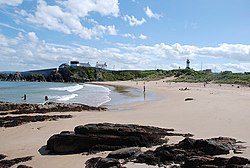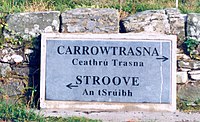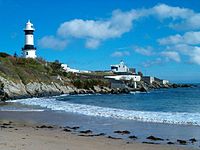Shrove
| Shrove Irish: An tSrúibh | |
| County Donegal | |
|---|---|
 Beach at Shrove | |
| Location | |
| Grid reference: | C682427 |
| Location: | 55°13’37"N, 6°55’46"W |
| Data | |
| Local Government | |
| Dáil constituency: |
Donegal |
Shrove (pronounced 'Shroove', to rhyme with 'prove'[1]) is a coastal hamlet and townland on the eastern coastline of Inishowen, a broad peninsula in the north of County Donegal.[2] The hamlet is located a short distance to the north of Greencastle in the north-east of Inishowen.
The hamlet strands beside White Bay, also known as Big White Bay, at the southern end of the townland of Shrove. Shrove Strand, also known as Shrove Beach, runs along the western edge of White Bay, the bay being slightly to the north of the entrance into Lough Foyle. Shrove lies immediately north of Magilligan Point, a hamlet a short distance away on the opposite shore in County Londonderry.
Shrove is at the northern end of the Wild Atlantic Way route.
Name
The name of both the hamlet and the townland is also sometimes written as Shroove, and has sometimes written as 'Stroove' in official publications.[1][3]
The name in the Irish language is An tSrúibh and was originally, Srúibh Bhrain[4]

Shrove is known in the English language by several different names.[1] All but one of these names (that being the erroneous 'Inishowen Head') are derived from its earliest-recorded Irish language place-name, which was Srúbe Brain, later written as Srúibh Bhrain, meaning either 'Point / Beak of the Raven' or 'Bran's Point'.[4] Srúibh Bhrain was originally the name for the headland that later became known, in the English language, as Inishowen Head, a headland also known as Inishowen Heid (Ulster-Scots), Shrove Point, Shrove Head, or Shrove Heid (Ulster-Scots).[4] Srúibh Bhrain still remains the official Irish language name for Inishowen Head, the headland at Shrove that juts out into the Atlantic Ocean.[4]
Over the centuries, the name of the coastal settlement and townland beside White Bay also became known as Srúibh Bhrain, later being shortened to An tSrúibh, which simply means 'The Point' or 'The Beak'.[4] It is from the word Srúibh that most of the English language names for the hamlet derive, these names being Shrove, Shroove and Stroove.[4][1] However, locally, the name of both the hamlet and the townland has been written in English as Shrove for centuries, with that spelling always being pronounced locally as 'Shroove' (to rhyme with 'prove').[1] The local pronunciation of the place-name Shrove ('shroov') is very similar to how Srúibh is pronounced in the County Donegal dialect of Ulster Irish.
The names 'Inishowen Head' and 'Stroove' have been used in recent publications and tourist brochures, but this has not been popular locally, where locals insist that their hamlet is called Shrove.[1]
Inishowen Head

Inishowen Head is a prominent headland in the townland of Shrove that juts out into the Atlantic Ocean.[2] The headland is the most easterly place on the County Donegal mainland, and is located just to the north of Big White Bay. The original name for the headland was Srúibh Bhrain remains the official Irish language name for Inishowen Head.
Shrove lighthouses

The two lighthouses at Shrove, both located at Dunagree Point, were designed by George Halpin and were built in the 1830s.[5][6] The lighthouses were built at the suggestion of the Londonderry Ballast Office.[6] The light in the East Lighthouse was decommissioned in 1961, while the West Lighthouse remains in use.[5][6] The structures are sometimes referred to as the Inishowen Head Lighthouses, and both are owned and operated by the Commissioners of Irish Lights.[6]
Mercedes Gleitze
In August 1929, Mercedes Gleitze]], the professional British sea swimmer, swam from Shrove in Inishowen across to Portstewart, a small town on the coast of County Londonderry.[7] As 'the crow flies', this is a distance of around 11 miles, Portstewart being to the south-east of Shrove. This involved swimming in the open sea, just north of the entrance into Lough Foyle. Gleitze had become internationally famous in October 1927 for completing the first known swim across the English Channel by a British woman.[8] As far as is known, she was only the third woman in history to swim across the English Channel.
Gleitze initially attempted to swim from Portstewart across to Inishowen, making this attempt on 15 August 1929.[7] However, she had to abandon this attempt half-way through, being brought the rest of the way by a motor boat to Moville on the Inishowen side.[7] Unperturbed by this upset, she decided to try again, this time swimming from Inishowen across to Portstewart.
At 3am on the morning of Saturday, 17 August 1929, Gleitze left her lodgings at McConnell's Hotel (now The Foyle Hotel) on The Square in Moville.[7] She was conveyed by motor car to the Pilot's Station at Inishowen Head in Shrove, where, at exactly 4:05am, she entered the water.[7] From Shrove, she swam directly across to Portstewart. This swim took just over eight hours, which she successfully completed, becoming the first known person to complete this feat. She emerged from the sea at Bearnville Port in Portstewart at 12 noon later the same day.[7]
Gleitze made the 'return swim' a few days later, on 20 August 1929. On this occasion, she swam from Portstewart to Black Rock Bay, between Moville and Greencastle.[7]
References
- ↑ 1.0 1.1 1.2 1.3 1.4 1.5 ""We can prove...it's Shrove": Greencastle townland reclaims its name". Inishowen News. 9 December 2008. http://www.inishowennews.com/08ShroveName.htm.
- ↑ 2.0 2.1 "Stroove Townland, Co. Donegal". https://www.townlands.ie/donegal/inishowen-east/moville-lower/greencastle/stroove/.
- ↑ An tSrúibh / Stroove: Placenames Database of Ireland
- ↑ 4.0 4.1 4.2 4.3 4.4 4.5 McKay, Patrick (1999). A Dictionary of Ulster Place-Names. Belfast: The Institute of Irish Studies, The Queen's University of Belfast. pp. 137-138.
- ↑ 5.0 5.1 Alistair Rowan, The Buildings of Ireland: North West Ulster, p. 319. Yale University Press, London, 2003 (originally published by Penguin Books, London, 1979).
- ↑ 6.0 6.1 6.2 6.3 "Our Lighthouses - Inishowen Lighthouse". Commissioners of Irish Lights. https://www.irishlights.ie/tourism/our-lighthouses/inishowen.aspx.
- ↑ 7.0 7.1 7.2 7.3 7.4 7.5 7.6 "Mercedes Gleitze: Open Water and Endurance Swimmer - Lough Foyle (both ways; 15 August, 17 August and 20 August 1929)". https://www.mercedesgleitze.uk/lough-foyle.
- ↑ "Mercedes Gleitze: Open Water and Endurance Swimmer - Personal Details and Summary of Career". https://www.mercedesgleitze.uk/personal-details-and-summary-of-career.